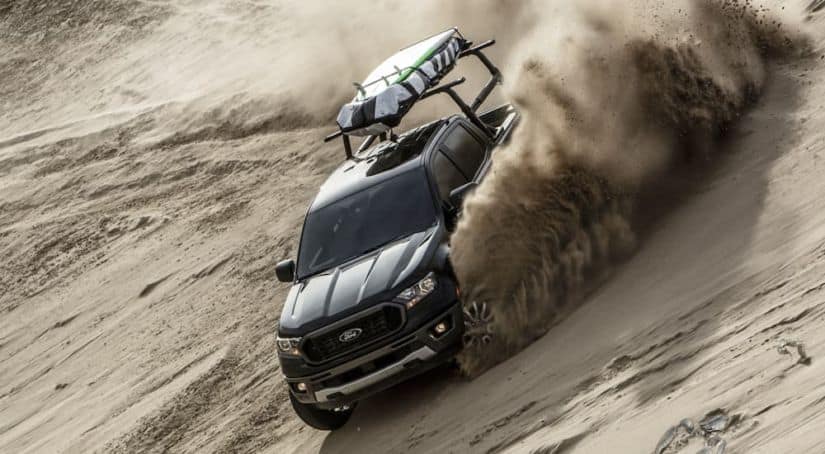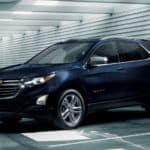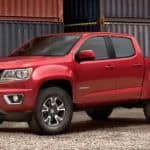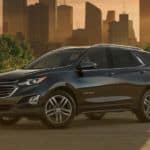What should you expect from a top-grade midsize pickup truck? While there are many models out there that make a lot of promises, it is quite difficult to live up to expectations. Those who favor the pickup truck body styling often have high expectations for their vehicles, expecting them to provide incredible power, while at times delivering a level of comfort comparable to a well-sized SUV. So, which models live up to their promises? Well, two pickup models stand out to us: the 2020 Ford Ranger vs 2020 Chevy Colorado, two pickup trucks with a lot of potential at first glance. Ford and Chevy have had a rivalry since the beginning of the auto industry; it’d only make sense that they’d develop two of the most praised pickup truck models on the market. While both vehicles exist within similar lanes, only one can be considered superior, and we’ll pick apart either model to see which might make the better purchase.
On Face Value
At first glance, the 2020 Ford Ranger and the 2020 Chevy Colorado are two similar pickup trucks that issue plenty of promise. On the one hand, you have the Chevy Colorado with its low-end entry MSRP of $21,300. While the baseline pricing is quite low, the cost increases quite rapidly, especially when you take a gander at the trim options. There is more than enough choice within the Chevy Colorado lineup, as drivers can select from the Base, WT, LT, Z71, and ZR2, with ZR2 models starting at an MSRP of $41,400. The Ford Ranger, on the other hand, is a bit pricier starting out at $24,410; that said, the Ford Ranger only has three trim levels the XL, XLT, and Lariat. However, the top-end trim, the Lariat, starts out at an MSRP of $32,500. While there are fewer trims to choose from in the Ford Ranger, this isn’t necessarily a bad thing, as if each trim manages to provide substantial features, the exact number of trims shouldn’t matter too much.
All that said, we believe that to compare two pickup trucks, we’ll need to look at more than just the trims and pricing. So, to give you a better idea of which pickup truck may be the better buy, we’ll delve into the details such as performance and utility features.
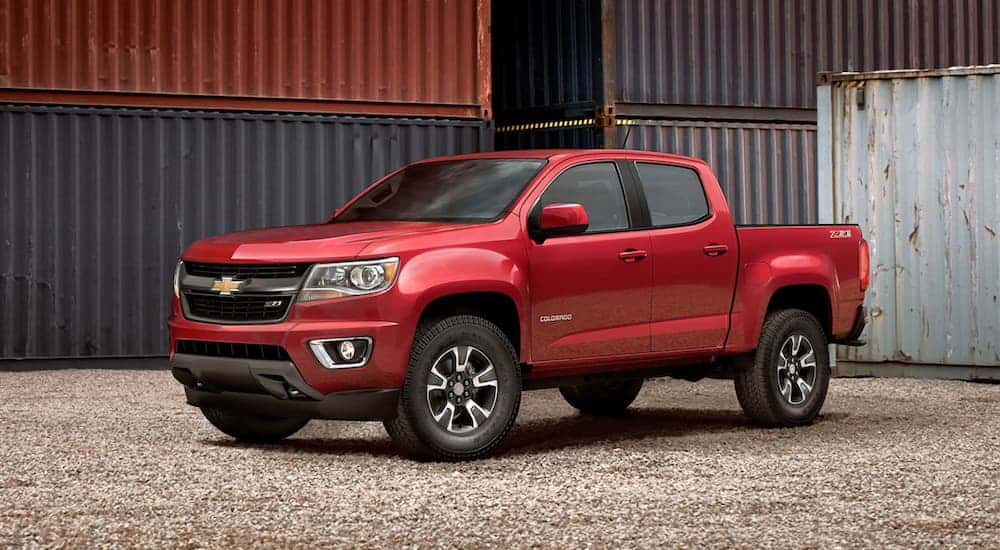
The Power and Performance of Both Trucks
Performance can play a massive role in determining the difference between two pickup trucks. Trucks are often expected to be utility powerhouses that not just provide a responsive and robust driving experience, but they also should be able to haul plenty of cargo and not hesitate in the process of doing so. Both the Ford Ranger and the Chevy Colorado issue out some considerable powertrains across their trim levels; however, their overall performance is far from being the same.
The Chevy Colorado, with its plethora of trim levels, offers three different powertrain options to drivers. The base model is powered by a 2.5-liter four-cylinder engine that produces 200 horsepower and 191 lb-ft of torque, all with the help of a rather nimble 6-speed automatic transmission and rear-wheel drivetrain. You can advance on this entry-level powertrain, however, as higher trims sport a 3.6-liter V6 engine that uses an 8-speed automatic transmission and yields 308 horsepower and 275 lb-ft of torque. On top of that, this engine also is one of the most tow-capable of the group, with a max towing capacity of 7,000 pounds. A 2.8-liter turbodiesel V6 is also available in the Chevy Colorado and with the help of a 6-speed automatic transmission, has a relatively worthwhile 369 lb-ft of torque. In trims like the ZR2 though, the Chevy Colorado can be transformed into an off-road trekker thanks to a heightened suspension system, unique dampers, a limited-slip rear differential, and locking differentials.
Performance in the Ford Ranger is a little more substantial at baseline levels, with the entry model sporting a 2.3-liter turbo-4 engine that has 270 horsepower and 310 lb-ft of torque. That said, this is the only available engine option, even if it is a rather capable one. Putting the limiting options aside, the Ford Ranger still uses a 10-speed automatic transmission to funnel power, which makes the vehicle rather light on its feet, and the 7,500-pound towing capacity doesn’t hurt too much either. If you invest in the FX4 package, you also get a Ford Ranger that comes with a part-time four-wheel drive system that can handle itself quite well on rough terrain. The FX4 package comes with additional bells and whistles, which include off-road traction modes and electronically controlled rear differentials.
In terms of performance, it appears as though the Ford Ranger is the clear upset with its small yet mighty turbocharged four-cylinder engine. But there is more than just performance to consider when investing in a new pickup truck.
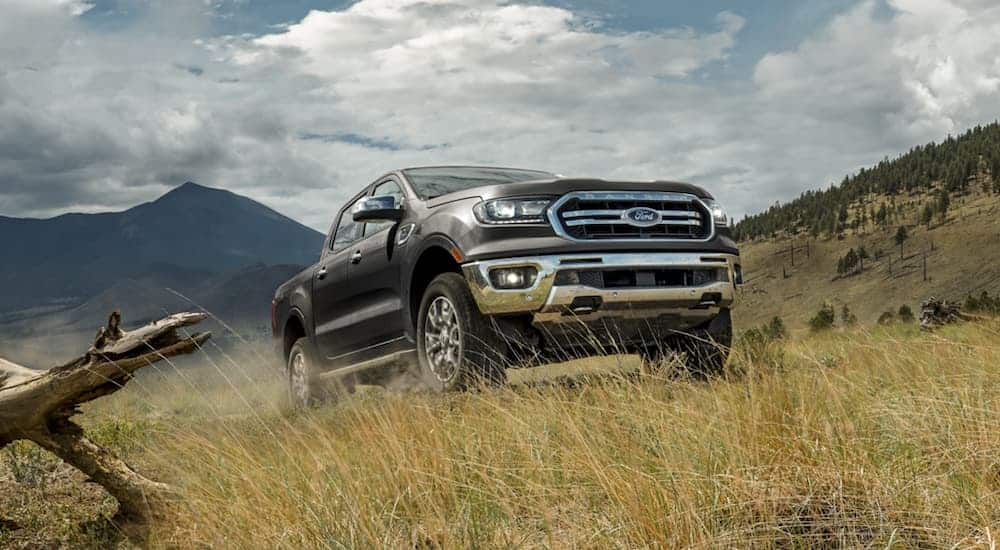
Utility and Tech
Of course, a highlight of any pickup truck is the rear bed. Meant for hauling cargo, a truck bed can define a whole truck and can make the difference between a good by and an okay one. The truck bed of the Chevy Colorado is decent, with two options available: a 5.1-foot bed and one measuring in at 6.2-feet. Meanwhile, the Ford Ranger isn’t far behind with drivers being able to choose between a 5-foot bed and one that’s 6-feet. The extra inch or two of room makes the Chevy Colorado better for hauling; however, the level of tech in either vehicle may shift your perspective.
Tech features are important in any vehicle, let alone a pickup truck, and both of these models provide a substantial listing in higher trims, but drops the ball in base models. The Chevy Colorado, for instance, comes with the bare minimum, including things like cloth upholstered seating, a simple air conditioning system, and a four-way power driver’s seat. That said, the Base and Work Truck models of the Chevy Colorado do get a 7.0-inch infotainment system that comes with Apple CarPlay and Android Auto, something you’ll have to pay extra for in the Ford Ranger. The level of tech expands as you move up the trim option ladder; however, the Chevy Colorado falls rather short when you pay a focus on driver assistance features. The Chevy Colorado only includes driver assistance features in higher-tiered models, although, regardless of the trim, you can’t expect to find automatic emergency braking, a feature found standard on many vehicles nowadays.
The Ford Ranger, on the other hand, offers less in terms of infotainment, but more in the way of safety and driver assistance. The base model XL has a rather spartan interior, with only a 4.2-inch display for your infotainment needs. This screen will expand to 8-inches by opting for either the XLT or Lariat. You do get power features on the XL, Bluetooth connectivity, and even automatic emergency braking. This safety feature is a big deal for many drivers, and it is one of many onboard the Ford Ranger with higher trims adding blind-spot monitors and adaptive cruise control to the mix.
Which is the Better Pickup Truck
When comparing these two pickup trucks, there is a lot to consider between things like performance, safety tech, and truck bed sizing. And while the Chevy Colorado offers more in terms of trim options, it is difficult to disregard the remarkable power of the Ford Ranger’s opening power train. Nor can we forget about the lack of automated features on the Chevy Colorado’s entry-level model. For this reason, we’d suggest the 2020 Ford Ranger over its long-time rival the Chevy Colorado. Although, you shouldn’t just take our word for it, as you should see for yourself, which may be the better fit for your needs.
